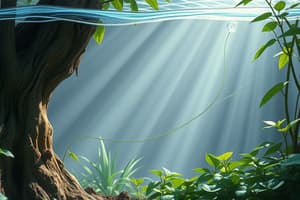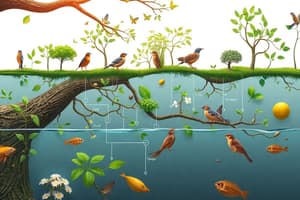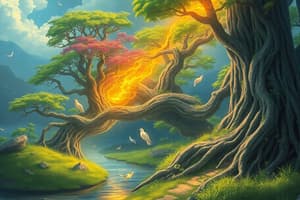Podcast
Questions and Answers
What defines the role or position that an organism has in its environment?
What defines the role or position that an organism has in its environment?
- Community
- Habitat
- Niche (correct)
- Population
Which of the following is classified as a biotic factor in an ecosystem?
Which of the following is classified as a biotic factor in an ecosystem?
- Temperature
- Sun energy
- Trees (correct)
- Rocks
What type of organisms are called producers in an ecosystem?
What type of organisms are called producers in an ecosystem?
- Autotrophs (correct)
- Heterotrophs
- Decomposers
- Carnivores
Which statement correctly describes primary consumers?
Which statement correctly describes primary consumers?
Which of the following best describes a food web?
Which of the following best describes a food web?
Which term refers to the non-living components of an ecosystem?
Which term refers to the non-living components of an ecosystem?
What role do decomposers play in an ecosystem?
What role do decomposers play in an ecosystem?
Which statement about autotrophs is true?
Which statement about autotrophs is true?
What is the primary difference between a habitat and a niche?
What is the primary difference between a habitat and a niche?
Which best describes a food chain's role in an ecosystem?
Which best describes a food chain's role in an ecosystem?
Which of the following is an example of a tertiary consumer?
Which of the following is an example of a tertiary consumer?
Which of the following statements correctly describes heterotrophs?
Which of the following statements correctly describes heterotrophs?
How do decomposers contribute to an ecosystem?
How do decomposers contribute to an ecosystem?
Which factor would be categorized as abiotic?
Which factor would be categorized as abiotic?
Which statement best represents the meaning of an ecological niche?
Which statement best represents the meaning of an ecological niche?
What does a food web illustrate about ecosystem interactions?
What does a food web illustrate about ecosystem interactions?
Flashcards are hidden until you start studying
Study Notes
Ecosystem Interactions
- Ecosystems are made up of biotic (living) and abiotic (non-living) factors.
- Biotic factors include:
- Deer
- Bacteria
- Fish
- Fungi
- Trees
- Insects
- Abiotic factors include:
- Water
- Wind
- Rocks
- Sun energy
- Temperature
- Land
Habitat vs. Niche
- A habitat is the area where an organism lives.
- An ecological niche is the role or position an organism has in its environment.
- Niche defines how an organism meets its needs for food, shelter, and reproduction.
Cycle of Energy
- Autotrophs: Organisms that collect energy from sunlight or inorganic substances to produce food.
- Example: Plants, algae, some bacteria.
- Heterotrophs: Organisms that get energy by consuming other organisms.
- Also called consumers.
- Primary consumers: Herbivores that feed on producers.
- Secondary consumers: Carnivores that feed on primary consumers.
- Tertiary consumers: Carnivores that feed on secondary consumers.
Trophic Levels
- Each step in a food chain or food web is called a trophic level.
- Ecological Tithe Law: 90% of energy is lost as heat between trophic levels, only 10% is transferred to the next level.
Models of Energy Flow
- Food Chains: Simple model showing the flow of energy through an ecosystem. Arrows represent the one-way energy flow, typically starting with autotrophs and moving towards heterotrophs.
- Food Webs: Complex model representing the interconnected food chains and pathways in which energy flows through a group of organisms.
- Ecological Pyramids: Visual representation of the amount of energy or biomass at each trophic level.
Biotic and Abiotic Factors
- Biotic factors are living organisms within an ecosystem. Examples include deer, bacteria, fish, fungi, trees, and insects.
- Abiotic factors are non-living components of an ecosystem. Examples include water, wind, rocks, sunlight, temperature, and land.
- An ecosystem is a biological community and all of the abiotic factors that affect it.
Habitat and Ecological Niche
- A habitat is an area where an organism lives.
- An ecological niche is the role or position that an organism has in its environment.
- An organism’s niche is how it meets its needs for food, shelter, and reproduction.
Energy Cycles
- Producers are autotrophs (e.g., bacteria, algae, plants) that collect energy from sunlight or inorganic substances to produce food.
- Consumers are heterotrophs that get their energy requirements by consuming other organisms.
- Primary consumers are herbivores that feed on producers.
- Secondary consumers are carnivores that feed on primary consumers.
- Tertiary consumers are higher-level carnivores (e.g., sharks) that feed on secondary consumers.
- Decomposers (e.g., fungi and bacteria) convert organic matter into simple inorganic molecules.
Trophic Levels
- Ecologists use food chains and food webs to model the energy flow through an ecosystem.
- Each step in a food chain or food web is called a trophic level.
- Food chains are simple models showing the one-way energy flow through an ecosystem, starting with autotrophs and moving to heterotrophs.
- Food webs are more complex models representing the interconnected food chains and pathways of energy flow through a group of organisms.
- Ecological pyramids are models that demonstrate the amount of energy or biomass at each trophic level, with the base representing producers and each subsequent level representing consumers.
- The "Ecological Tithe Law" states that 90% of energy is lost as heat between trophic levels, with only 10% transferred to the next level.
Studying That Suits You
Use AI to generate personalized quizzes and flashcards to suit your learning preferences.




